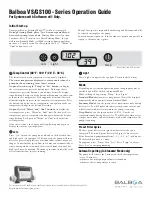
8 Configuration
Installer reference guide
50
ERLQ004~0 EHVH/X04+0 EHVH/X08S26CA
Daikin Altherma - Low Temperature Split
4P313775-1C – 2012.11
#
Code
Description
[A.3.1.2.4]
[0-04]
[0-05]
[0-06]
[0-07]
Set weather-dependent cooling:
[0-04]
[0-05]
Ta
Tt
[0-07]
[0-06]
▪ T
t
: Target leaving water temperature
(main)
▪ T
a
: Outdoor temperature
▪ [0-07]:
Low
outdoor
ambient
temperature. 10°C~25°C (default:
20°C)
▪ [0-06]:
High
outdoor
ambient
temperature. 25°C~43°C (default:
35°C)
▪ [0-05]:
Desired
leaving
water
temperature when the outdoor
temperature equals or drops below
the low ambient temperature.
Between minimum and maximum
leaving water temperature 5°C~22°C
(default: 12°C).
Note: This value should be higher
than [1-09] as for low outdoor
temperatures
less
cold
water
suffices.
▪ [0-04]:
Desired
leaving
water
temperature when the outdoor
temperature equals or rises above
the high ambient temperature.
Between minimum and maximum
leaving water temperature 5°C~22°C
(default: 8°C).
Note: This value should be lower
than [1-08] as for high outdoor
temperatures
colder
water
is
required.
Leaving water temperature: Delta T emitter
Temperature difference for entering and leaving water. The unit is
designed to support under floor loops operation. The recommended
leaving water temperature (set by the user interface) for under floor
loops is 35°C. In such case, the unit will be controlled to realize a
temperature difference of 5°C which means that the entering water
to the unit is around 30°C. Depending on the installed application
(radiators, heat pump convector, under floor loops) or situation, it
can be possible to change the difference between entering and
leaving water temperature. Note that the pump will regulate its flow
to keep the Δt.
#
Code
Description
[A.3.1.3.1]
[9-09]
Heating: required temperature
difference between entering and
leaving water. Range: 3~10°C (in steps
of 1°C; default value: 5°C).
[A.3.1.3.2]
[9-0A]
Cooling: required temperature
difference between entering and
leaving water. Range: 3~10°C (in steps
of 1°C; default value: 5°C).
Leaving water temperature: Modulation
Only applicable in case of room thermostat control. When using the
room thermostat functionality, the customer needs to set the desired
room temperature. The unit will supply hot water to the heat emitters
and the room will be heated. Additionally, also the desired leaving
water temperature must be configured: when turning on the
modulation, the desired leaving water temperature will be calculated
automatically by the unit (based on the preset temperatures, if
weather-dependent is selected, modulation will be done based on
the desired weather-dependent temperatures); when turning off the
modulation, you can set the desired leaving water temperature on
the user interface. Moreover, with the modulation turned on, the
desired leaving water temperature is lowered or raised in function of
the desired room temperature and the difference between the actual
and the desired room temperature. This results in:
▪ stable room temperatures exactly matching the desired
temperature (higher comfort level)
▪ less On/OFF cycles (lower noise level, higher comfort and higher
efficiency)
▪ water temperatures as low as possible to match the desired
temperature (higher efficiency)
#
Code
Description
[A.3.1.1.5]
[8-05]
Modulated LWT:
▪ No (default): disabled.
Note: The desired leaving water
temperature needs to be set on the
user interface.
▪ Yes: enabled
Note: The desired leaving water
temperature can only be read out on
the user interface
Leaving water temperature: Emitter type
Only applicable in case of room thermostat control. Depending on
the system water volume and the heat emitters type, the heat up or
cool down of a space can take longer. This setting can compensate
for a slow or a quick heating/cooling system during the heat up/cool
down cycle.
Note: The setting of the emitter type will influence the maximum
modulation of the desired leaving water temperature and the
possibility for usage of the automatic cooling/heating changeover
based on the indoor ambient temperature.
Therefore it is important to set this correctly.
#
Code
Description
[A.3.1.1.7]
[9-0B]
Emitter type:
Reaction time of the system:
▪ Quick Example: Small water volume
and fan coils.
▪ Slow Example: Large water volume,
floor heating loops.
8.2.6
Domestic hot water control
Only applicable in case an optional domestic hot water tank is
installed.
Configuring the desired tank temperature
The domestic hot water can be prepared in 3 different ways. They
differ from each other by the way the desired tank temperature is set
and how the unit acts upon it.
Summary of Contents for EHVH/X04+08S18CA
Page 111: ......
















































